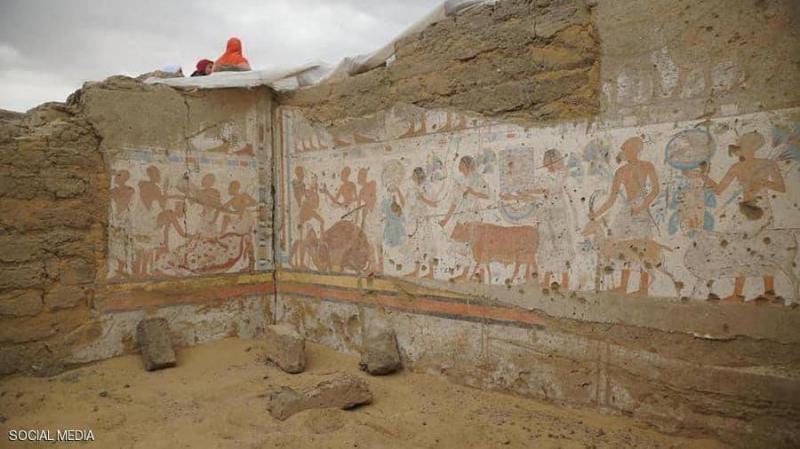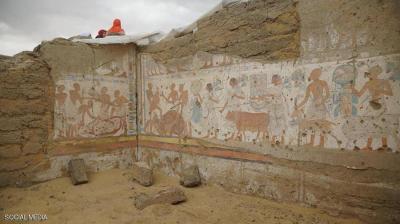On Saturday, the Egyptian Ministry of Tourism and Antiquities announced that a local excavation mission discovered the tomb of (Ptah-m-Wya), who served as the treasurer during the reign of King Ramses II, whose face was illuminated by the sun on October 22 in the Abu Simbel temple in southern Egypt. The discovery was made by a team from the Faculty of Antiquities at Cairo University, who are conducting excavations south of the causeway leading to the pyramid of King Unas in the Saqqara area of Giza Governorate.
The head of the mission, Ola Al-Ajizi, stated in a press release that the tomb belongs to the distinctive style of this location, referred to as the "tomb-temple," which consists of an entrance in the form of a portico followed by one or more courtyards, according to the Reuters agency. The tomb ends in the west with niches for deities, topped by a shrine. Currently revealed in the tomb is its entrance made of stone etched with scenes of the tomb's owner, leading to an initial hall with walls painted and colored on plaster.
Notable among these scenes is one depicting a procession carrying offerings, which culminates in a scene of a calf being slaughtered. Al-Ajizi mentioned that many carved stone blocks were found under the sand, as well as several Osirian columns, some lying in the sand while others remain upright in their original place.
King Ramses II belongs to the 19th dynasty of ancient Egypt, ruling from 1279 to 1212 BC. Mustafa Waziri, the Secretary-General of the Supreme Council of Antiquities, stated that the importance of discovering this tomb relates to the high-ranking positions held by its owner, who was the royal scribe, treasurer, chief overseer of cattle, and responsible for divine offerings in the temple of Ramses II at Thebes.
Furthermore, the discovery site includes the tombs of senior state officials from the New Kingdom, particularly from the 19th dynasty, complementing the site of the 18th dynasty tombs, which notably includes that of the military leader Horemheb.
### Sunlight on Ramses II’s Face
The solar alignment phenomenon occurs on the face of King Ramses II at the Abu Simbel temple in southern Egypt twice each year, once on October 22 and again on February 22. These dates have significance: the first marks the beginning of the harvest season for ancient Egyptians, while the second signifies the flood and agricultural season. Sunlight aligns with the inner sanctum of the Abu Simbel temples after penetrating the 200-meter-long front corridor of Ramses II's temple.
The marvel lies in whether these solar alignments were intentionally planned before the carving process, demanding profound knowledge of astronomy and complex calculations to establish the angle of the temple's axis in relation to the east, alongside architectural mastery to ensure the axis is straight over more than 60 meters. The complexity increases when considering these calculations were based on sound astronomical, geographic, topographical, and mathematical principles over 3,300 years ago.




